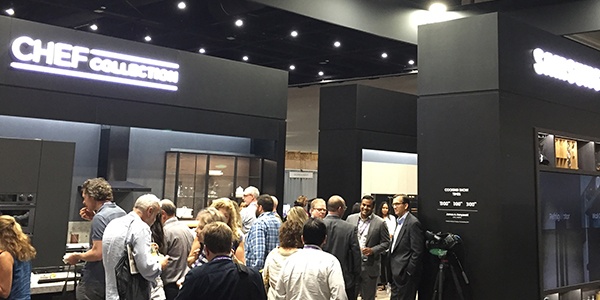
From Wi-Fi friendly thermostats to Bluetooth-enabled range hoods and automated mechanical parking lifts, this year’s Pacific Coast Builders Conference continued to showcase the latest and greatest in automated, connected and smart home building products. Yet, as brands proudly highlighted their unparalleled energy savings and consumer convenience benefits, one thing became abundantly clear.
Residential Internet of Things (IoT) products are still in a state of flux.
There’s no denying the recent explosion in the IoT space as well as the optimism that most have for the future. After all, McKinsey & Company estimates the IoT category will grow to $3.7 billion by 2020, attaining a 32.6% CAGR.
But as brands attempt to grow adoption rates and transform themselves from traditional building product manufacturers to technology solution providers, there are some barriers they’ll need to address.
Here are some of the challenges I noticed while at the conference:
- A fragmented ecosystem. In a category that seeks to unite physical objects with digital controls, you would think that overarching cohesion wouldn’t be an issue. But with so many products entering the space at the same time, a fragmented reality has been born. Think multiple networks, intrusive hardware and a laundry list of apps for the consumer to manage from product to product. Too many exhibitors at PCBC communicated the value of their smart products as stand alone pieces rather than part of an overall home experience.
- Cost vs. value-added. Like most emerging technologies, initial costs have prevented mass market entry. Some exhibitors were unveiling their second or even third iterations of smart product lines, now at lower price points. But even as prices come down, IoT home solutions have yet to displace traditional priorities for builders and homeowners in terms of overall value. As one builder said to me, “For most buyers, it’s not the most important thing. They’re still more focused on the type of kitchen countertop or cabinet we’re using. So it can be difficult to sell the value at a price that goes beyond the basic spec package.”
- Buying committee convergence. As physical and digital worlds collide, the lines begin to blur and cause confusion between professionals who specify, purchase, install and support product maintenance. In multi-family markets, property owners may not be up to speed on the latest use of intelligent technologies whereas those involved in technical support may be less proficient in getting involved with the physicality of the building. Additionally, building product manufacturers lack clarity on specification practices and struggle to communicate with architects, designers and engineers who tend to be risk-averse with new technologies.
So what can brands do to target builders better?
Some exhibitors at PCBC showcased integration options with other home automation solutions such as Amazon’s Alexa or Apple’s HomeKit. Brands should continue to explore connectivity possibilities that can be controlled by a single source in order to create a better customer experience.
Smart product suppliers should also examine the difference between technological novelty and applicable value. For example, does the average homeowner really want a tool to preset their shower temperature or are they more concerned about water efficiency?
Finally, as the professional buying committee becomes more complex, success will depend on a manufacturer’s ability to connect the right message to the right audience across their marketing and sales channels. At PCBC, rarely did an exhibitor begin the conversation by asking if I was a builder and what type of projects I work on. It’s critical that strategies for segmentation align with other marketing and sales practices in order to deliver the right experience and move a pro through a buying path.
Do you need help transitioning from a traditional product manufacturer to a technology solution provider? Simply Contact us and let’s discuss how to communicate the right message to your audience.